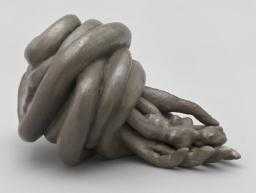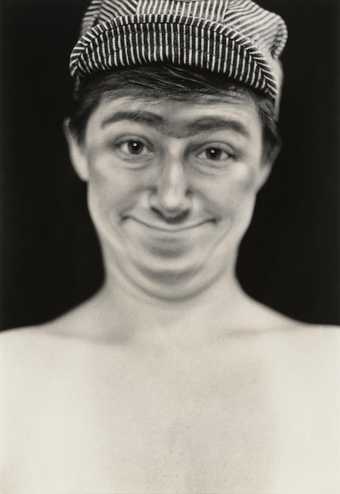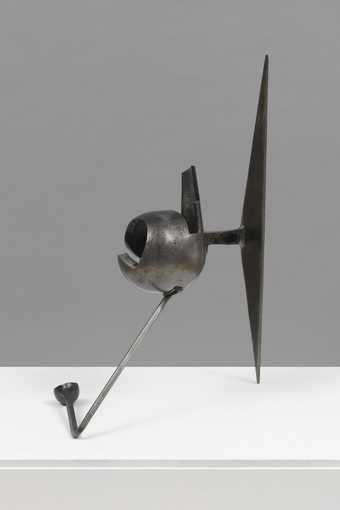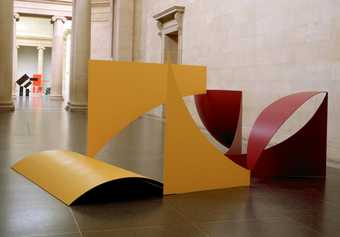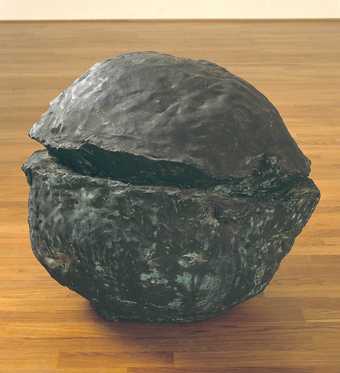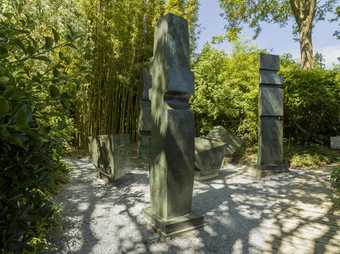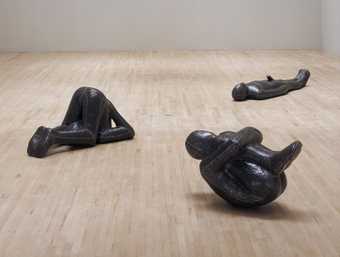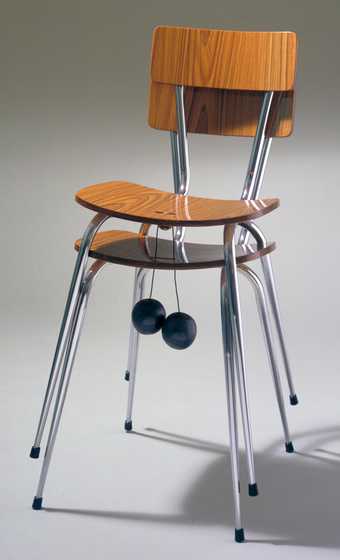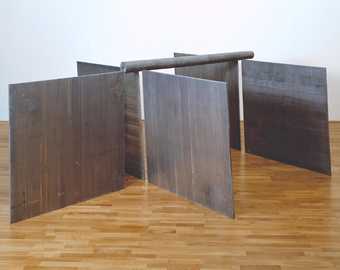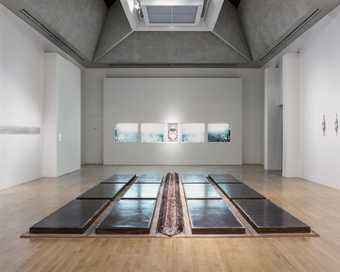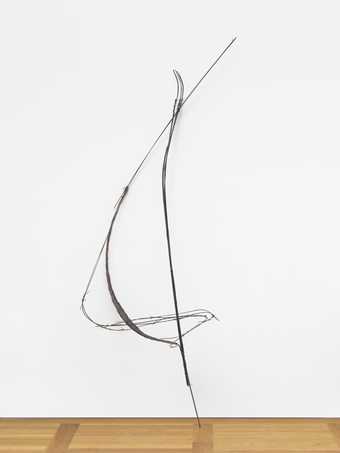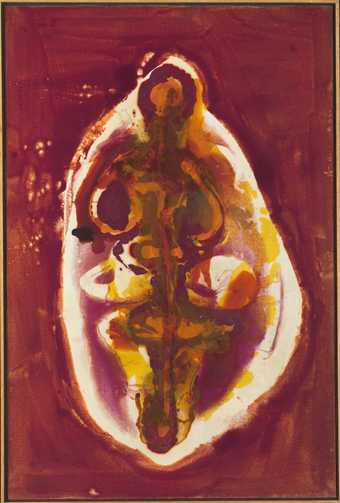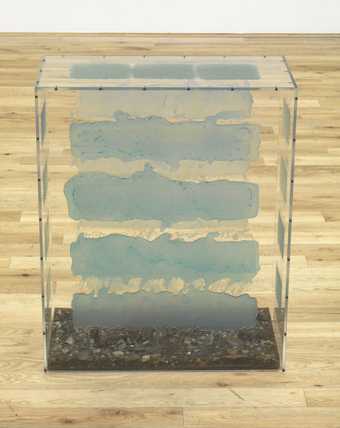Not on display
- Artist
- Lynda Benglis born 1941
- Medium
- Lead and steel on steel base
- Dimensions
- Object: 1500 × 1680 × 1580 mm, 976 kg
- Collection
- Tate
- Acquisition
- Presented by the American Fund for the Tate Gallery, partial purchase and partial gift of John Cheim and Howard Read 2010
- Reference
- T13353
Summary
Quartered Meteor is a lead sculpture to be displayed in the corner of a gallery space. The work is a cast of a form originally made from piled layers of polyurethane foam. Benglis first made foam sculptures as works in themselves; these were by necessity temporary and ephemeral. Casting the foam works in bronze not only ensured their longevity as artworks; it was a deliberate attempt to subvert and make uncanny the material presence of the objects. In this work the static, heavy nature of the lead is at odds with the foam’s amorphous shape, recalling the appearance of cooled lava.
Benglis is one of the key figures of American Post-Minimal art of the 1960s and 1970s. She is arguably best known for brightly coloured poured latex works. However the metal sculptures of which Quartered Meteor is a seminal example represent an important part of her early practice. Like many other artists of her generation, Benglis often worked from the principle that form should be derived from the inherent qualities of her chosen materials. Transformed from foamy globs into solid masses of metal, these works signal the artist’s sophisticated understanding of the differing nature of materials.
The curator and critic Richard Marshall has described Benglis’ intention with these works, saying:
The artist was fascinated with metals not only because of their permanence, but primarily because of their inherent attributes – energy, reflective surface, value as a natural resource, and capability of being returned to a liquid state. Quartered Meteor suggests a molten mass that has entered the earth’s atmosphere and slammed into a corner (Marshall, p.6).
Critic Tom Hess expands on the cast sculptures’ reference to natural processes:
Benglis’ concern with making soft things hard while preserving their insouciant memories of softness may or may not have something to do with feminism, phallicism, and other politico-sensualities. She is more concerned, I think, with the Romantic concept of the artist as a force of Nature. Nature can change states – freeze water, melt rocks; Benglis, too, can congeal or liquefy matter – and in the process make sculpture as calculated, precise, and refined as icicles (quoted in press release for ‘Bettina Rheims/Lynda Benglis’, Cheim & Read, New York 2002, http://www.cheimread.com/exhibitions/2002_10_bettina-rheims--lynda-benglis/?view=pressrelease).
Tate’s work is the first of an edition of three. It is the sole edition to have been cast in 1975, and the only edition made in lead. Two subsequent editions in aluminium have been produced but these are double-dated, ensuring that they will remain distinguished from the vintage cast owned by Tate.
Further reading:
Richard Marshall, Lynda Benglis, exhibition catalogue, Cheim & Read, New York 2004, reproduced in colour p.17.
Carter Radcliffe, Lynda Benglis, exhibition catalogue, Locks Gallery, Philadelphia 2002.
Rachel Taylor
January 2009
Does this text contain inaccurate information or language that you feel we should improve or change? We would like to hear from you.
Display caption
This work was originally made by pouring polyurethane foam into the corner of a gallery. The bottom and two flat sides are effectively a cast of the floor and walls, while the slumps on the front result from the unpredictable behaviour of waves of slowly solidifying foam. It was cast in lead in 1975, giving the sculpture physical weight and presence. While many artists were interested in the literal properties of materials, Benglis wanted to suggest bodily and geological flows.
Gallery label, October 2016
Does this text contain inaccurate information or language that you feel we should improve or change? We would like to hear from you.
Explore
- abstraction(8,615)
-
- from recognisable sources(3,634)
-
- organic(827)
- non-representational(6,161)
-
- irregular forms(2,007)
- formal qualities(12,454)
- environment / nature(315)
- transformation(186)
- education, science and learning(1,416)
-
- geology(33)
- gender(1,689)
You might like
-
Louise Bourgeois Nature Study
1986 -
Cindy Sherman Untitled B
1975 -
Bryan Kneale MBE Knuckle
1964 -
Henry Moore OM, CH Upright Form: Knife Edge
1966 -
Phillip King Dunstable Reel
1970 -
Lucio Fontana Nature
1959–60 -
Dame Barbara Hepworth Conversation with Magic Stones
1973 -
Sir Antony Gormley OBE RA Three Ways: Mould, Hole and Passage
1981–2 -
Richard Wentworth Siege
1983–4 -
Richard Serra 2-2-1: To Dickie and Tina
1969, 1994 -
Cathy De Monchaux Never forget the power of tears
1997 -
Shelagh Cluett Flux III
1979 -
Magda Cordell No. 12
1960 -
Tom Hudson Box of Clouds
1965–72


